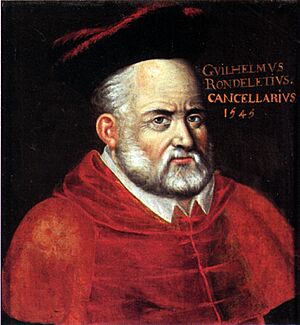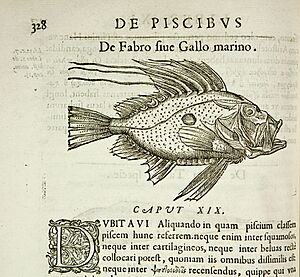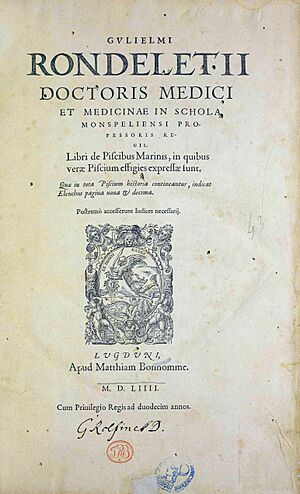Guillaume Rondelet facts for kids
Quick facts for kids
Guillaume Rondelet
|
|
|---|---|

Guillaume Rondelet in 1545
|
|
| Born | 27 September 1507 |
| Died | 30 July 1566 (aged 58) Réalmont, Kingdom of France
|
| Nationality | French |
| Alma mater | University of Paris |
| Scientific career | |
| Fields | Anatomy Botany Medicine Zoology |
| Institutions | University of Montpellier |
| Academic advisors | Johann Winter von Andernach |
| Doctoral students | Felix Plater |
| Other notable students | Volcher Coiter |
| Author abbrev. (botany) | Rondelet |
Guillaume Rondelet (born September 27, 1507 – died July 30, 1566) was a famous French doctor and scientist. He taught medicine at the University of Montpellier in southern France. He was also the head of the university from 1556 until he passed away.
Rondelet was well-known for studying the human body (anatomy) and nature (natural history). He was especially interested in plants (botany) and fish (ichthyology). His most important work was a big book about sea animals. This book took him two years to write and was used as a main reference for about 100 years. But his biggest impact was teaching many brilliant students who became important scientists themselves.
Contents
Early Life and School
Guillaume Rondelet was born in Montpellier, France, in 1507. His father sold spices and medicines, like a pharmacist. Rondelet's father died when he was young, so his older brother raised him. He was often sick until he was 18 years old.
He went to school in Montpellier and then to Paris in 1525. There, he studied Latin and philosophy at the University of Paris.
Starting Medical Studies
In 1529, Rondelet returned to Montpellier. He became very interested in medicine and joined the medical school at his hometown university. In 1530, he became a student registrar, helping with student records. Around this time, he became friends with another doctor, François Rabelais. Rabelais later wrote a famous book where he made fun of Rondelet a little bit, calling him "Rondibilis."
While he was a registrar, Rondelet removed Nostradamus from the university. Nostradamus had just joined but was removed because he was an apothecary (someone who prepared and sold medicines).
Life as a Doctor and Teacher
After getting his first degree from Montpellier, Rondelet moved to a town called Pertuis. He tried to earn money by teaching children, but it didn't go well. So, he went back to Paris to learn Greek and study anatomy again. He supported himself by teaching.
For a while, he worked as a doctor in Maringues. Then, in 1537, he returned to Montpellier. He finished his doctorate degree there and married Jeanne Sandre the next year. They lived with Jeanne's sister for seven years.
His medical practice wasn't very successful. He had trouble managing his money. In 1539, he became a teacher at the medical school. However, a few years later, the plague spread in Montpellier. This meant he had very few students left; by 1543, only three remained.
Working with Cardinal de Tournon and Studying Sea Animals
Rondelet's luck changed when he found a powerful supporter, Cardinal François de Tournon. Rondelet became his personal doctor. The Cardinal and the Bishop of Montpellier had even been sponsors for Rondelet's twin children when they were born in 1538.
Rondelet left Montpellier and traveled with Cardinal de Tournon. They journeyed all over France, what is now Belgium, and Italy. He stayed in Rome for 13 months in 1549 and 1550. His trip to Italy allowed him to meet many Italian scholars he knew from letters, like Luca Ghini and Ulisse Aldrovandi. While in Italy, he could explore his interest in natural history by visiting the coast.
His Big Book on Marine Animals
In 1545, Rondelet was made a Royal Professor of Medicine at Montpellier, which showed his growing importance. He returned to his hometown in 1551 after leaving the Cardinal's service. He then spent two years writing a huge book about sea animals. Its title was Libri de piscibus marinis in quibus verae piscium effigies expressae sunt.
Even though the title mentioned "fish" (piscibus), the book covered all kinds of water animals. Like other scientists of his time, he didn't separate fish from sea mammals like seals and whales, or from crabs and other creatures without backbones. He also wondered if freshwater creatures could live in the sea and vice versa.
Rondelet studied animals in a way similar to the ancient Greek thinker Aristotle. He looked at how and why different body parts worked. For example, he compared the swim bladders of freshwater and saltwater fish. He cut open and drew many creatures. His drawing of a sea urchin is the oldest known drawing of an invertebrate (an animal without a backbone). He also found important similarities in the body structures of dolphins, pigs, and humans.
His book was published in 1554. It became a main reference for many years and was translated into French in 1558. The French title was L'histoire entière des poissons ("The complete history of fish").
Teaching and Famous Students
Rondelet was a popular and good teacher. In 1556, he was chosen as the head (chancellor) of Montpellier University. Many of his students became very famous scientists. Some of them were Charles de l'Écluse, Matthias de l'Obel, and Felix Platter. Felix Platter came to Montpellier when he was only 15, riding a pony all the way from Switzerland!
Under Rondelet's leadership, the university attracted students from all over France and other countries. The French king, Henry II, even gave money to the university. Rondelet convinced the King to pay for building a special anatomy theater in Montpellier.
However, the university faced problems because of growing disagreements between different religious groups in France. These disagreements led to the French Wars of Religion in 1562. Many students came from parts of France where Protestant ideas were popular, which was also true for Rondelet's home region. These students couldn't study at other universities controlled by Catholics. Rondelet himself got involved in these religious issues when his friend Bishop Pellicier was put in prison. Rondelet protested by burning his own theology books. It's not clear if Rondelet became a Protestant later in his life, but he seemed interested in their ideas.
Last Days
In the summer of 1566, Rondelet went to Toulouse to help some family members. It was very hot, and the city wasn't very clean, so many people got sick with dysentery (a serious stomach illness). By the end of July, Rondelet also got sick.
Even though he was ill, he traveled to Réalmont with a friend. He went there because his friend asked him to care for his sick wife. When he arrived, Rondelet's condition got worse. He died in Réalmont on July 30, 1566.
Works
- Libri de piscibus marinis in quibus verae piscium effigies expressae sunt. Mathias Bonhomme, Lyon, 1554. Digital edition of the Bibliothèque nationale de France.
- Gulielmi Rondeletii de ponderibus : sive de iusta quantitate et proportione medicamentorum liber. [S.l.] ; Antverpiae : Plantin, 1561. Digital edition of the University and State Library Düsseldorf.
- Dispensatorium sev pharmacopolarum officina : adiecto indice copioso. Byrckmann, Köln 1565. Digital edition of the University and State Library Düsseldorf.
A type of fish (Rondeletia) and a plant (Rondeletia) are both named after Guillaume Rondelet.
See also
 In Spanish: Guillaume Rondelet para niños
In Spanish: Guillaume Rondelet para niños



